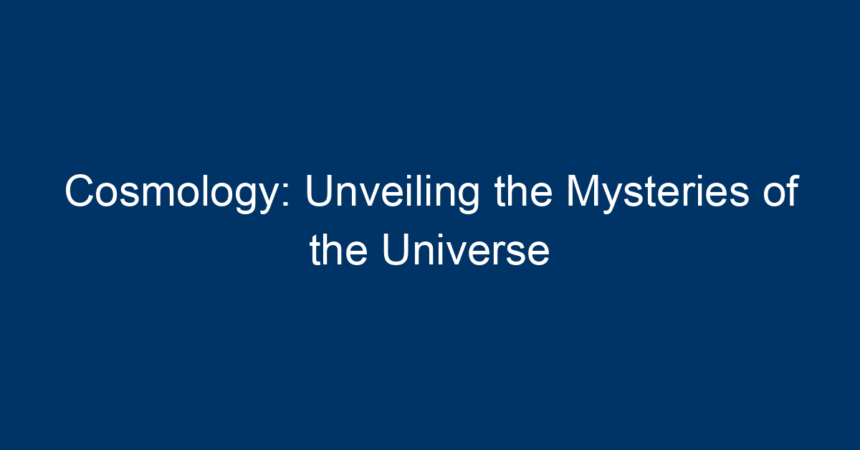The universe is a vast and enigmatic expanse, teeming with secrets waiting to be unraveled. Cosmology, the scientific study of the origins and evolution of the universe, serves as our gateway to understanding these extraordinary mysteries. From galaxies spiraling in the cosmic void to the profound implications of dark matter and dark energy, cosmology is not just a branch of science; it’s a profound inquiry into our existence and the nature of everything around us. In this article, we will delve into the fundamental concepts of cosmology, explore its historical developments, and consider its future implications.
What is Cosmology?
Cosmology is fundamentally concerned with the large-scale structure of the universe and its historical context. It seeks to explain how the universe began, how its components interact, and how it evolves over time. By integrating knowledge from fields such as physics, astronomy, and even philosophy, cosmology provides a comprehensive understanding of our cosmos.
Key Concepts in Cosmology
The Big Bang Theory
One of the cornerstones of modern cosmology is the Big Bang Theory, which posits that the universe expanded from an extremely hot and dense singularity about 13.8 billion years ago. This theory is supported by several key observations:
-
Cosmic Microwave Background Radiation (CMB): A faint glow that fills the universe, the CMB is a relic of the early universe, providing crucial evidence for the Big Bang.
-
Hubble’s Law: The observation that galaxies are receding from each other suggests that the universe is continuing to expand.
- Abundance of Light Elements: The amounts of hydrogen, helium, and lithium found in the universe align with predictions made by the Big Bang nucleosynthesis model.
Each of these factors adds layers to our understanding, making the Big Bang Theory a pivotal element of cosmology.
Dark Matter and Dark Energy
Although visible matter—planets, stars, and galaxies—constitutes only about 5% of the universe, the remainder is filled with dark matter (27%) and dark energy (68%).
-
Dark Matter: This mysterious substance does not emit light or energy, making it invisible. However, its existence is inferred from gravitational effects it exerts on visible matter. Understanding dark matter is crucial for mapping out the universe’s structure.
- Dark Energy: This enigmatic force is believed to be responsible for the accelerated expansion of the universe. Dark energy poses some of the biggest questions in cosmology, as its nature remains largely unknown.
Cosmic Inflation
Cosmic inflation refers to a hypothesized exponential expansion of space in the early universe. This theory addresses several puzzles associated with the Big Bang, such as the uniformity of the cosmic microwave background radiation. It posits that a brief period of rapid expansion occurred, smoothing out any irregularities.
The Historical Journey of Cosmology
The evolution of cosmology is a rich tapestry woven through centuries of philosophical and scientific inquiry.
Ancient Cosmologies
Early examples of cosmology are found in ancient cultures, where myths and celestial observations shaped their understanding of the universe. The Greeks, particularly Aristotle and Ptolemy, proposed geocentric models where Earth lay at the center of the universe.
The Copernican Revolution
The Copernican Revolution marked a seismic shift in cosmology. Nicolaus Copernicus introduced a heliocentric model, placing the Sun at the center. This radical idea, later supported by figures like Galileo and Kepler, transformed our perspective and laid the foundation for modern astronomy.
Einstein’s Contributions
Albert Einstein revolutionized our understanding of gravity with his General Theory of Relativity. This theory replaced Newtonian gravity, providing a more comprehensive framework for understanding the curvature of space-time. Relativity plays a pivotal role in contemporary cosmological models and our understanding of large-scale structures in the universe.
The Modern Era of Cosmology
With advancements in technology and observational techniques, cosmology has entered an exciting modern era.
Observational Techniques
From the Hubble Space Telescope to ground-based observatories, astronomers can now study distant galaxies, cosmic microwave background radiation, and gravitational waves, leading to significant discoveries in cosmology.
The Role of Computer Simulations
Advanced computer simulations allow cosmologists to model formations of galaxies and the large-scale structure of the universe. These simulations provide insights into how dark matter influences galactic formations over billions of years.
The Future of Cosmology
As we look to the future, cosmology holds promises and challenges that could reshape our understanding of the universe.
Technological Advancements
The development of next-generation telescopes, such as the James Webb Space Telescope and the European Extremely Large Telescope, is set to revolutionize observations. These tools will allow us to peer deeper into the cosmos than ever before, potentially answering some of the most profound questions in cosmology.
Unsolved Mysteries
Despite our advancements, numerous unresolved mysteries remain. Questions such as:
- What is the true nature of dark matter and dark energy?
- Is the universe finite or infinite?
- How do black holes affect cosmic evolution?
are still at the forefront of cosmological research. Addressing these queries will require collaboration across multiple scientific disciplines and possibly new physics.
Actionable Insights
-
Stay Informed: Follow developments in cosmology through reputable science news outlets and journals. Websites like NASA, the European Space Agency, and academic journals such as The Astrophysical Journal provide comprehensive updates.
-
Engage with Science: Participate in community events or online forums centered around astronomy and cosmology. Understanding the science behind the universe fosters deeper appreciation and engagement.
- Support Scientific Research: Consider contributing to or advocating for funding in scientific research organizations which explore cosmological phenomena. Grassroots support can make a significant difference in expanding our understanding of the universe.
Conclusion
Cosmology offers a profound lens through which to view and understand the universe. By unraveling the complexities of the cosmos—from the Big Bang to dark matter—we gain not only knowledge but also a deeper appreciation for our place within this vast, mysterious expanse. As we stand on the brink of new discoveries, every inquiry and every experiment brings us one step closer to unlocking the secrets nestled within the fabric of the universe. Embrace the quest for knowledge and continue your exploration of cosmology and its revelations.




